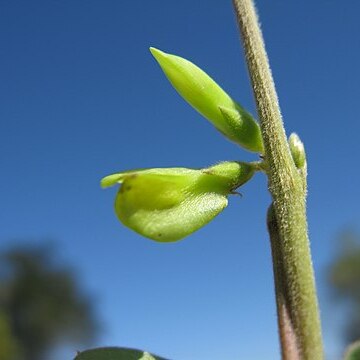Climbing or trailing herb up to 3.5 m long, from a perennial woody rootstock. Stems annual, glabrous or with golden appressed or spreading pubescence. Leaves 3-foliolate; leaflets 1-6.8 x 0.5-4 cm, elliptic to ovate, pubescent to glabrous on both surfaces, generally obtuse to slightly acuminate at the apex, mucronulate, rounded at the base; petiole 8-45 mm long; rhachis 2-8 mm long; petiolules 2 mm long; stipules 2-5 x 1-2 mm, ovate, truncate at the base, striate; stipels 2-3 mm long, linear. Flowers axillary, in pairs or in 3-4(10)-flowered fascicles; pedicels 2-3 mm long; bracts 2-3 mm long, linear-lanceolate; bracteoles 2-5 mm long, linear. Calyx pubescent; tube 2-3 mm long; lobes 2-5 mm long, triangular, acuminate, upper pair completely fused. Standard white, green to yellow with purple blotch at base, 12-30 x 6-18 mm, oblong to oblong-elliptic, emarginate, with lamelliform appendages up to 7 mm long; wings 10-18 mm long; keel 8-18 mm long. Ovary 4-5 mm long, densely appresssed sericeous-pilose. Pods 3-8 cm x 5-8 mm, linear-oblong, compressed, glabrous to pubescent, 3-8-seeded; beak 3-15 mm long. Seeds beige to deep red mottled black, 3-4 x 2-3 x 0.5-1.5 mm; hilum small, central.
Perennial, climbing or trailing herb, up to 3.5 m long; stems with dense spreading hairs, arising from a stout woody rootstock. Leaves pinnately trifoliolate. Leaflets elliptic, ovate or subrhombic, often with a margin of whitish hairs. Stipules ovate-lanceolate. Flowers axillary, in 2-4(-10)-flowered fascicles, whitish, yellow-green to yellow with a purplish spot on inside of standard petal near centre. Flowering time Aug.-Mar., sometimes to June. Pod linear-oblong, compressed, beaked, glabrous to pubescent.
Leaves 3-foliolate; leaflets 1–6.8 × 0.5–4 cm, elliptic to ovate, pubescent to glabrous on both surfaces, generally obtuse to slightly acuminate at the apex, mucronulate, rounded at the base; petiole 8–45 mm long; rhachis 2–8 mm long; petiolules 2 mm long; stipules 2–5 × 1–2 mm, ovate, truncate at the base, striate; stipels 2–3 mm long, linear.
A herb. It is a slender vine. The leaves are compound. The leaflets are 2-7 cm long by 2-4 cm wide. The leaves are hairy. The flowers are in a compact group. The flowers are 9-11 mm across. The fruit is a flat pod 4-5 cm long by 1 cm wide. They are hairy. There are 4-8 seeds in each pod.
Standard white, green to yellow with purple blotch at base, 12–30 × 6–18 mm, oblong to oblong-elliptic, emarginate, with lamelliform appendages up to 7 mm long; wings 10–18 mm long; keel 8–18 mm long.
Flowers axillary, in pairs or in 3–4(10)-flowered fascicles; pedicels 2–3 mm long; bracts 2–3 mm long, linear-lanceolate; bracteoles 2–5 mm long, linear.
Calyx pubescent; tube 2–3 mm long; lobes 2–5 mm long, triangular, acuminate, upper pair completely fused.
Pods 3–8 cm × 5–8 mm, linear-oblong, compressed, glabrous to pubescent, 3–8-seeded; beak 3–15 mm long.
Seeds beige to deep red mottled black, 3–4 × 2–3 × 0.5–1.5 mm; hilum small, central.
Climbing or trailing herb up to 3.5 m long, from a perennial woody rootstock.
Stems annual, glabrous or with golden appressed or spreading pubescence.
Ovary 4–5 mm long, densely appresssed sericeous-pilose.

